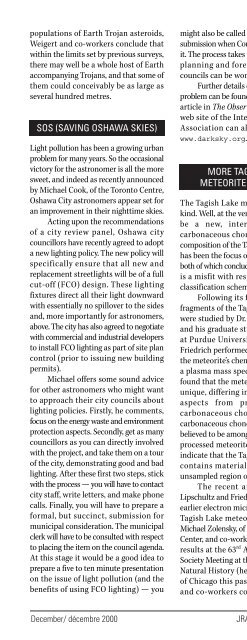I N S I D E T H I S I S S U E
insidethisissue - The Royal Astronomical Society of Canada
insidethisissue - The Royal Astronomical Society of Canada
- No tags were found...
You also want an ePaper? Increase the reach of your titles
YUMPU automatically turns print PDFs into web optimized ePapers that Google loves.
scheduler automatically chooses theexposure time for the satellite based onits range from the facility and its elevationabove the horizon (for sight obliquity).This scheduler has been thoroughly tested,and it is now ready to be integrated intothe CASTOR system for future automation.The CASTOR project is currently inits research and development stage andthe first CASTOR facility in Kingston(CASTOR K) should be automated by thesummer of 2001.The FutureThe CASTOR K facility at RMC in Kingstonwill be the first of three CASTOR facilitieslocated in Canada. The second CASTORfacility (CASTOR S) will be located at theDefense Research Establishment Suffield(DRES) in southern Alberta. The thirdCASTOR facility (CASTOR V) has beenproposed for the Defense ResearchEstablishment Valcartier (DREV) insouthern Quebec. The purpose of havingthree facilities is twofold. First, the weatheris a major concern for optical telescopes.The probability of overcast skies at allthree facilities is smaller than that at onesingle facility. Second, satellite trackingdata obtained from more than one facilityis better than those obtained from a singleone, because data from two or morefacilities can be used for parallaxdeterminations of the satellite’s range.As a result, not only angle data are obtainedfrom the facilities, but range data as well.This improves the orbital determinationaccuracy and therefore will provide abetter ephemeris for finding the satelliteat a later time.These three facilities will be linkedvia a secure network to a single commandcentre located at the SSRAL. After thislink is established, the three facilities willbe used remotely from the commandcentre. Weather sensors at each site willprovide a synopsis of the respective facility’ssky conditions in real-time.Michael Earl is currently a senior technicianat the Space Surveillance Research andAnalysis Laboratory at the Royal MilitaryCollege, Kingston, Ontario. For the past threeyears, he has been responsible for the designand testing of various satellite trackingfacilities, including the Canadian AutomatedSmall Telescope for Orbital Research.Astronomy at RMCThe Royal Military College of Canadahas in its possession many astronomicaltelescopes for general purpose usessuch as open houses and undergraduateprojects. The Department of Physicsat RMC currently owns ten 5-inchreflecting telescopes, two 8-inchCelestron telescopes, and the 10-inchMeade Quartz telescope that wasoriginally used by the SSRAL for trackingsatellites.Plans are being made for at leastthree open houses to be held everysummer. These open houses are generallyfor the staff at RMC as well as RASCmembers. RMC also offers undergraduateand graduate degrees in Space Science.See the RMC web site for more details:www.rmc.ca.Visit the RASC Websitewww.rasc.caRASC INTERNET RESOURCESContact the National Officerasc@rasc.caJoin the RASC’s E-mail Discussion ListThe RASCals is a forum for discussion among members of the RASC. The forum encourages communication among members across the country andbeyond. It began in November 1995 and currently has about 265 members.To join the list, send an e-mail to listserv@ap.stmarys.ca with the words “subscribe rascals Your Name (Your Centre)” as the first line of themessage. For further information see: www.rasc.ca/computer/rasclist.htm218JRASC December / décembre 2000
















